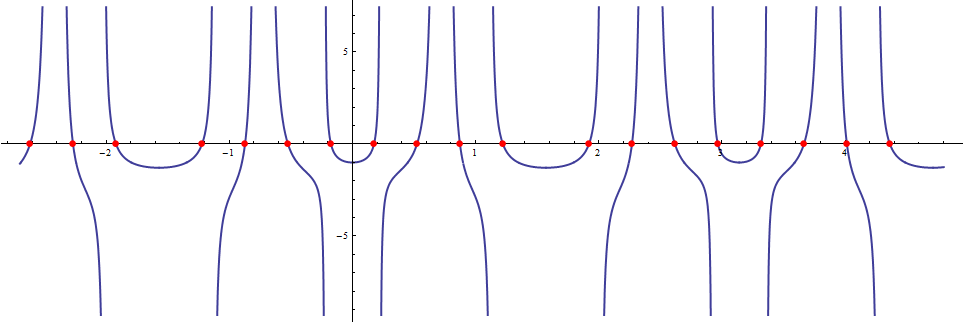Solutions to algebraic or transcendental equations are expressed in terms of Root objects whenever it is impossible to find explicit solutions. When polynomial Root object does have an expression in terms of radicals, it can be expanded using ToRadicals. The reverse operation is RootReduce.
In general, there is no way express roots of 5-th (or higher) order polynomials in terms of radicals. However even higher order algebraic equations can be solved explicitly if an associated Galois group is solvable. On the other hand Solve and Reduce behave differently by default, e.g. evaluate Reduce[x^4 + 3 x + 1 == 0, x] and Solve[x^4 + 3 x + 1 == 0, x], this justifies apparently different outputs :
Options[#, {Cubics, Quartics}] & /@ {Reduce, Solve}
{{Cubics -> False, Quartics -> False}, {Cubics -> True, Quartics -> True}}
or read another related post.
Using Solve you could include this option InverseFunctions -> True to avoid any messages generated :
s = Solve[(3 - Cos[4x])(Sin[x] - Cos[x]) == 2, x, InverseFunctions -> True]

nevertheless you won't get all solutions, only three of them are real numbers :
Select[ s[[All, 1, 2]], Element[#, Reals] &]
{-π, π/2, π}
In general, it is recommended to use Reduce rather than Solve when one is looking for a general solution, mainly because the latter yields only generic solutions. Another reason is that lists must be of finite length while boolean form of Reduce output is more appropriate to include infinite number of solutions. However in our case one can add the option MaxExtraCondition to express full set of solutions, e.g.
Solve[(3 - Cos[4x])(Sin[x] - Cos[x]) == 2, x, MaxExtraConditions -> All]
{...,
{x -> ConditionalExpression[
2 ArcTan[ Root[1 + 12 #1^2 - 8 #1^3 - 26 #1^4 + 28 #1^6 + 8 #1^7 + #1^8 &, 8]]
+ 2 π C[1], C[1] ∈ Integers] }, ...}
With Reduce we needn't use any options and we'll get all i.e. infinitely many solutions, evaluate e.g. :
Reduce[(3 - Cos[4x])(Sin[x] - Cos[x]) == 2, x]
There is no problem with infinitely many solutions since the function is periodical and in a given period all roots are expressed in terms of a finite number of polynomial roots.
Real solutions are integer multiples of π/2 and for the rest Mathematica cannot decide whether they are transcendental or algebraic numbers, to check it try e.g. :
Element[#, Algebraics] & /@ s[[All, 1, 2]]
Note that Root objects represents the exact solutions, e.g. :
FullSimplify[(3 - Cos[4 x]) (Sin[x] - Cos[x]) - 2 /. s]
{0, 0, 0, 0, 0, 0, 0, 0, 0, 0, 0}
Root includes a pure function and an integer number pointing out explicitly a given root (here e.g. Root[1 - 4 #1 + 8 #1^2 - 4 #1^3 + 24 #1^5 - 24 #1^6 - 16 #1^7 + 16 #1^8 &, 1]) or (since ver.7) a list including a pure function and numerical approximation where we can find a root in case of a transcendental equation. This post may be helpful as well. Regardless of the form of representation Root can be exactly determined with an arbitrary accuracy, whatever one needs, let's take the fourth solution in s e.g. :
N[ s[[4]], 30]
{x -> -2.8504590137122308498000229727725413207035323228576
-0.2528465030753225904344011159589677330661689973232 I }
In case of Root is expressed by a transcendental function which has unbounded set of roots we have to restrict our searching to a bounded set including another condition, e.g. here we can restrict to -5 < Re[x] < 5, let's define :
g[x_, y_] := (3 - Cos[4 (x + I y)])(Sin[(x + I y)] - Cos[(x + I y)]) - 2
rsol = Reduce[(3 - Cos[4x])(Sin[x] - Cos[x]) == 2 && -5 < Re[x] < 5, x];
roots = {Re @ #, Im @ #} & /@ List @@ rsol[[All, 2]];
now we can visualize the geometrical structure of of the solution set :
GraphicsColumn[
Table[
Show[ ContourPlot @@@ {
{ f[ g[x, y]], ##, Contours -> 15, ColorFunction -> "AvocadoColors",
Epilog -> {PointSize[0.007], Red , Point[roots]}},
{ Re[ g[x, y]] == 0, ##, ContourStyle -> {Blue, Thick}},
{ Im[ g[x, y]] == 0, ##, ContourStyle -> {Cyan, Thick}}},
AspectRatio -> 3/10], {f, {Re, Im}}] & @ Sequence[{x, -5, 5}, {y, -1, 1}]]

The blue curves are sets of complex numbers x + I y where Re[ g[x, y]] == 0, while the cyan ones where Im[ g[x, y]] == 0, and the roots are denoted by red points.
We can see that we have 12 complex roots and 4 purely real ones, whereas Solve yielded respectively only 8 complex roots and 3 purely real.
For more information I recommend reading carefully e.g. an interesting post by Roger Germundsson on Wolfram Blog : Mathematica 7, Johannes Kepler, and Transcendental Roots.
Edit
Solving another equation of the OP I'd take :
Solve[ Tan[ 2x] Tan[ 7x] == 1, x, MaxExtraConditions -> All]
or simply
Reduce[ Tan[ 2x] Tan[ 7x] == 1, x]
All roots are real numbers :
Reduce[#, x] == Reduce[#, x, Reals] & [Tan[2 x] Tan[7 x] == 1]
True
Restricting our search to an interesting range of periodical function, let's denote :
hrs = List @@ Reduce[ Tan[ 2x] Tan[ 7x] == 1 && -5 < Re[x] < 5, x][[All, 2]];
now we can plot the roots :
Plot[ Tan[ 2x] Tan[ 7x] - 1, {x, -2.7, 4.8}, AspectRatio -> 1/3, PlotStyle -> Thick,
Exclusions -> {Cot[2x] == 0, Cot[7x] == 0},
Epilog -> {Red, PointSize[0.007], Point[Thread[{#, 0}& @ hrs]]}]

